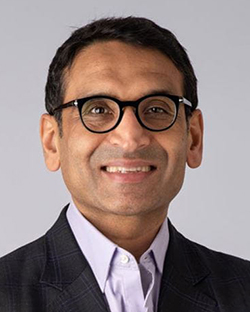
Collins Aerospace is investing in next-generation heat sinks to make brakes last longer.
Ajay Mahajan became Collins Aerospace’s president of Advanced Structures in November 2022 after leading its landing systems business, which is now part of his larger group. He spoke with Lee Ann Shay about how the company is preparing for new fleets, changing technologies and the evolution of new materials.
Are there any changes to the business?
Advanced Structures combines the aerostructures and mechanical systems businesses and contains four product lines. They include aerostructures (the nacelles business and landing systems), landing gear and brakes, actuation systems, and propellers. The idea of combining them was to enable technology development across the four businesses.

They run as separate portfolio businesses, but there are capabilities and technology connections that give us a better opportunity to leverage all of them. It’s a high-performing portfolio; we will continue to invest in it to grow the capabilities.
What investments are you making in the near term?
The single biggest focus in the near term is getting ready for this big aerospace ramp-up that is coming. When you look at the Airbus A320neo, A350, Boeing 737 MAX and military programs, for instance, we are on about all of them, and our main focus is being able to deliver on commitments. That requires investing in our own manufacturing shop capacity as well as the supply chain.
When looking one to three years out, most investments will be getting ready for next-gen aircraft programs from Boeing and Airbus. They’re still working on the designs, but we know they will require lighter weight and more sustainable materials, for example. So we need to think of creating lighter, longer-lasting, more sustainable and high-performing products using advanced materials and manufacturing processes. As an example, we are investing in thermoplastic composites.
We bought DTC in the Netherlands, which gave us ready-to-deploy thermoplastics capabilities. Thermoplastics could save more than 50% on weight for some components and do not require the use of an autoclave.
For wheels and brakes, we’re investing in next-gen heat sinks to make brakes last longer.
For actuation, OEMs are thinking of thin-wing architectures, which could require lightweight flight control surfaces and use integrated actuation systems that allow the whole flight control system to be used as a line-replaceable unit. [That] would reduce the manufacturing time, assembly time and maintenance time.
For the propeller business, we’re thinking of different composite blades.

What are your supply chain pains?
The supply chain is one thing that keeps me up at night. Advanced Structures is a global business. We have 40-plus different sites. About 60-70% of my cost is in the supply chain, so I cannot be successful if my suppliers are not performing. We’ve seen improvements, but we’re not out of the woods yet, and we hope to see an inflection point later this year or early next year. Machining and engineered materials are the two biggest commodities where we are spending the most time. For engineered components, the suppliers are responsible for the whole design as well as the manufacturing, so they have issues with their sub-tiers. We are spending a lot of time working with them. The typical role of a supply chain organization has evolved from being transaction-oriented to spending time at the supplier and working with them. It’s become a contact sport, and it’s going to take a while to get us over the hump.
Are you expecting more mergers and acquisitions within your supply chain?
There already is some consolidation happening in some parts of the supply chain and it’s happening for the right reasons, in that a combination produces a more robust company that serves customers. That can actually be a good thing for us.
Collins signed an agreement in March with Etihad Engineering to embed nacelles MRO within its operation. Do you plan to make any changes to your service network, including new partnerships or joint ventures?
That deal had been in the works for a long time so it was good to close that. It’s a win-win for us and the customer. Our overall MRO strategy is to be close to the customer. Proximity matters. Having a footprint—either fully owned or through a partnership—that reduces logistics and turnaround times is the strategy. When we talk with customers, we ask how we can support them better. If a big fleet decision is coming and that fleet decision is contingent on meeting service-level requirements, we look at how we can best be positioned to support them and create a win-win solution.
